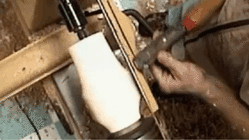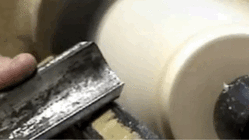My wife and I were invited to a famous turners (they live semi-locally) shop recently after I demonstrated at a Woodturners club. Apparently this meeting has been going on for 35+ years and we were honored to be invited. He demoed a simple centerwork piece, and then asked if anyone wanted to try and make the same piece on his lathe. No one else volunteers so I did. It was a piece of curly white oak, and the demonstrator used the Roughing Gouge mostly to make theirs, but I wanted to use a 5/8" wide by maybe 1/4" think skew with what could have been a 30 degree combined bevel angle. As I was using it, i was getting alot of chatter. I was turning at the max #2 belt at 1800 and it was a piece 2.5" diameter. By the time I was done shaping it, there were major tearout. The demostrator said that the skew is the wrong tool for the application, since the skew doesn't do well with interlocking or funky grain. When I asked if it was because the roughing gouge had so much more steel, he replied by saying the roughing gouge is doing 2 cuts at once, a roughing cut and a slicing cut. There was further discussion but they said if you put it under a microscope, you will see. So, i made the last finished cuts with the roughing gouge, not understand how the steel was able to produce that finish. Bare in mind, it was a demo under time, and we had to leave earlier due to babysitting restraints, so we couldn't ask him about it. Some people also get silently annoyed (


 ) with my engineering-like brain that wants to understand exactly why things happen, primarily when their time is being used to explain it. I don't know him that well or the crowd yet to put them through a detailed explanation on a microscopic level. lol. So I want to figure it out on my own, and come back to him next month with an intelligent question. Does anyone have a literature or a video that explains this? Or is someone able to ELI5?
) with my engineering-like brain that wants to understand exactly why things happen, primarily when their time is being used to explain it. I don't know him that well or the crowd yet to put them through a detailed explanation on a microscopic level. lol. So I want to figure it out on my own, and come back to him next month with an intelligent question. Does anyone have a literature or a video that explains this? Or is someone able to ELI5?
Thanks for reading and Anyone to contributes to the "Make My Brain Rest" foundation!



Nick
Thanks for reading and Anyone to contributes to the "Make My Brain Rest" foundation!
Nick



